    
François Conchon (*1837, 1874 – 1898, †1913)
Firma „Star Works“
Release maker

Tunesheet of N° [10]
Place des Alpes 9, and rue des Paquis 2, Geneva. Germain traces François Michel Conchon back to France where he was born c. 1837. He married in Geneva in 1869 and was listed for the first time as a musical-box manufacturer in 1874. By about 1878 he claimed to employ annually fifty workers and to produce all the parts of his musical boxes in his workshops `to reduce their cost´. The business ceased on 27 May 1898 and Conchon died in February 1913. Made good-class musical boxes and some excellent three and four-comb pieces.
Later Conchon produced helicoidal movements under the style name `A L´Étoile´ and at this time his trademark was a five-pointed star interlaced with a lyre. A Conchon helicoidal, the cylinder making six revolutions before backing away from the comb, is in the Guiness collection, New York.
(Ord-Hume, Musical Boxes, p. 299)
Conchon Helicoidal
F. Conchon never seemed to be in any doubt about
the versatility of his ideas or his output. The former
is noted in a letter of his dated 27 -LL-I89I (in Vol. 6,
page 186) and the latter is clearly expressed in his
unpacking and operating instructions. These were
headed by a location picture of his Star Works flanked by lists of'his products in French and English.
[...]
The instmctions printed below covered all types of musical boxes except helicoidals. All were quite
conventional except: If after a time, the instrument
shows signs of slackeningplace a drop offine watch
oil on the screw-worm B. [...]
Conchon also issued some specific instructions,
for example with serial9662 whose tune sheet has
the Star Works trade mark at top left, and F.
CONCHON, Fabricant, GENEVE in the top border.
The heading above the list of tunes reads:"Interchangeable Continuous play CylindersSublime Harmony Piccolo and Bells". A Helicoidal! !
The accompanying special instructions are
stupifyingly verbose and further hindered by
uninspired translation from the French. They take
a lot of words to explain that with helical pinning
there is no tune gap on the cylinder which is pinned
all round and therefore has to be moved away from
the comb for its return to tune 1. They powerfully
emphasize that the triggers at each end of the
cylinder bearings must be firmly pressed down to
move the cylinder away from the comb before a
cylinder is changed and also before using the tune
selector. . . . "pressingthem until a snappingsound
is heard which is a sign that the unlatching is
entirely produced - then the cylinder can be placed
on the bridges without fear ofhurting either the pins
of the cylinder or the small hair spring under each
tooth of the comb." No clue is given as to how the movement of the
cylindertowards and awayfromthe comb is achieved;
the explanatory note simply reads . . . . It has been
necessary to combine a mechanism producing the
recoiling of the cy'inder to a sufficient distance
backwards fromthe comb in orderthento allowittoslide from the last revolution to the first and then to
come of itself against the comb to play from the
beginning, all these different movements being done
automatically.
This Conchon helicoidal system is probably simpler and certainly quite different from that patented by
Arthur Junod in 1896 and explained with drawing
in Vol. 7, page 184. Conchon first exhibited a helicoidal
in 1878, but probably it was not an interchangeable.
Conchon 9662 has three 6-air cylinders, two of them conventional with operatic airs up to 1879 and
the third a helicoidal. described on the tune sheet "continuous play cylinder," with the Wm. Tell
overture. The Sublime Harmonie combs have 42 teeth each with separate combs for Piccolo, 30 teeth,
and six for the six bells. The cylinders are 15" (38cm)
by 2.4" (6cm) diameter, having 70 seconds per tune
[...]. The box was made
in 1892 - according to Fig. 6.
Sound early advice
It is sometimes sobering to read up-to-date advice
set out by craftsmen centuries ago.
When you have cast the bells in the way
described above, if the tones are imperfectly
matched through negligence or carelessness,
correct them. If you want to have a bell witha higher tone, file the bottom of the rim;
if lower, fiIe round the rim on the outside.
This quote is taken from Book 3, Chapter 87, "Small Musical Bells," written [...] by Theophilus, a Benedictine monk. The complete work
is entitled "On Divers Arts" translated from the
Latin by Hawthorne and Smith, Dover Publications,
New York. It ranges from painting to wire-dradrg,from stained glass windows to hardening files, and
gives a good picture of 12th Century craftsmen.
eather conditions at Ste. Croix Arthur Junod's daughter Edith collected picture
post cards in the 1903-1914 period and several in her
collection including one reproduced here in Fig. 8 are
reminders of the severe winter weather at Ste.
Croix, sometimes with very persistent snow and
cloud cover blanketing the area.
The railway from Yverdon was successfully
planned to be reliable despite adverse weather,
though that involved a detour of about eight miles to
keep gradients [...] during the 2000 feet climb. The altitude at Yverdon on Neuchâtel
lake is 435 metres and at Ste Croix station 1066. The
town centre altitude is 1076, so you hadn't finished
climbing when you got off the train. TMB 16, 3, autumn/fall 1993, p. 81
https://www.mbsgb.org.uk/TMB/V16_B3.pdf
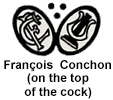


His trademark, stamped on the endless cock, was two ovals arranged like a butterfly´s wings, the left one carrying `F.C.L.´ and the right a musical lyre with three dots between the ovals / Trademark was a five-pointed star interlaced with a lyre. (Ord-Hume, Musical Boxes, p. 299)

Die Gesamtanzahl (Total) beträgt:
 Music boxes / Music boxes /  Spieldosen Spieldosen
10/5: •RoBelDonAubMeyer – HerWeSLanLab•
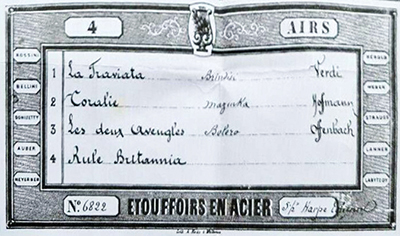
 Spielwerke: Spielwerke:
[Nummer 0, pattern],
Reprint,
6822
12/3: •BelMoRoWeMeyerFlot-VerDonSLabGSch•

 Spielwerke: no s/n (und bitte danach weiterklicken / and please click on the arrow to the right) Spielwerke: no s/n (und bitte danach weiterklicken / and please click on the arrow to the right)
16/1a: •BelMoRoWeAubHalWagPlanq – BoïeDonAdamOffVerFlotSullLec•

 Spielwerk: N° 4321 Spielwerk: N° 4321
 Weitere Spielwerke, Kapitel K 12/3 (Chapter 12/3) Weitere Spielwerke, Kapitel K 12/3 (Chapter 12/3)
Please click here to see  more music boxes more music boxes
François Conchon
Der Spielwerkproduzent François Conchon, erstmals in Genf gelistet 1874, nach Bulleid tätig bereits ab etwa 1861, Jahresproduktion etwa 400 Werke, ab 1895 Blechplatten statt der bisher üblichen Walzen, bis zur Auflösung der Firma im Jahr 1898
1861 |
Beginn der Produktion des 24-jährigen François Conchon |
1871 |
Werknummer ~4000 |
1873 |
Werknummer 5000 |
1876 |
Werknummer 6000 |
1880 |
Werknummer 7000 |
1883 |
Kompliziertes Werk: Werknummer 8258 spiralförmige Bestiftung, spielt 6 Musikstücke ohne Unterbrechung (TMB 16, S. 199) |
1885 |
Werknummer 8000 |
1890 |
Werknummer 9000 |
1898 |
Ende der Produktion Werknummer: <10000 |
(Bulleid 3rd Suppl., Chart 4, p. 51)
Teilnehmer bei der Nationalen Ausstellung in Zürich 1883
Die Firma François Conchon war zeitweise Visavisnachbar der Firma Ami Rivenc.
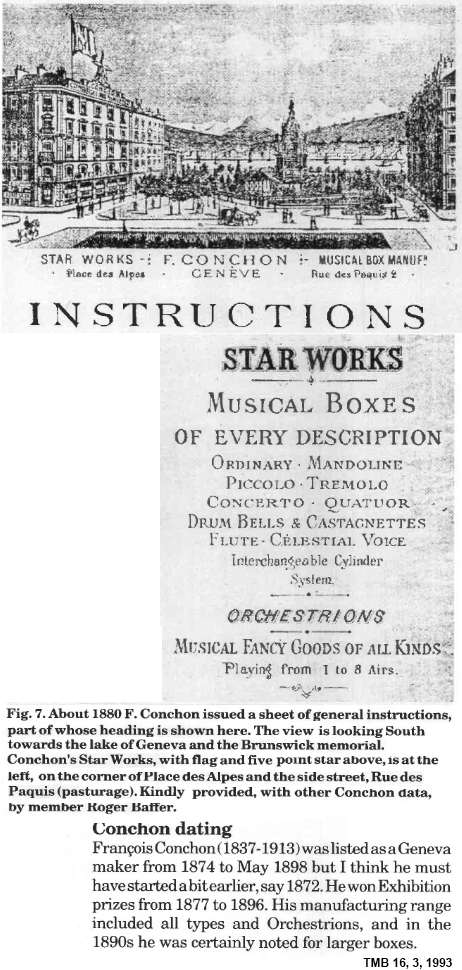
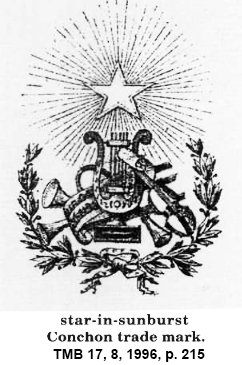
    
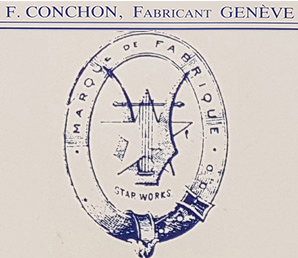
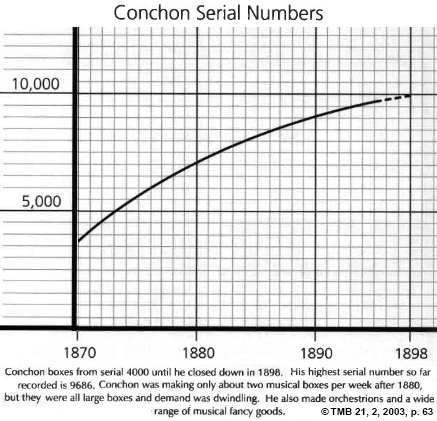
Spieldose mit Röhrenglocken
Verwendete in einem undatierten Werk auch Röhrenglocken. Zitat Antiquitätengeschäft Rau: The piece ingeniously allows for continuous play by means of a release attached to one of the arbor supports, while a dial on the left indicates which air is currently being played. The inclusion of twelve tubular bells adds depth and richness to the melodious sound produced by this mechanical music masterpiece. Also, thanks to a pair of zithers, the box is able to achieve a pizzicato, or plucked string effect, adding a layer of diversity to the box's overall sound. An incredible effort was clearly made to reproduce such expressive musical nuances. A very similar box was displayed by F. Conchon at the Swiss National Exhibition of 1896 in Geneva.

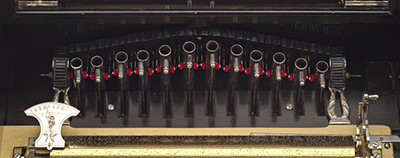
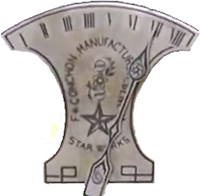

Sorgfältige Verarbeitung einer nicht nummerierten Spieldose ohne tune theet: Vernickelte Teile

Nickel finish components along with the blued steel bolts that secure the sublime harmony pair of comb. The already fancy adorned zithers with cast relief lyre decoration have plates beneath with neat looking clustered stars
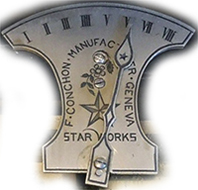 
Bulleid, Technology, p. 1
    
|
![]() more music boxes
more music boxes 




















